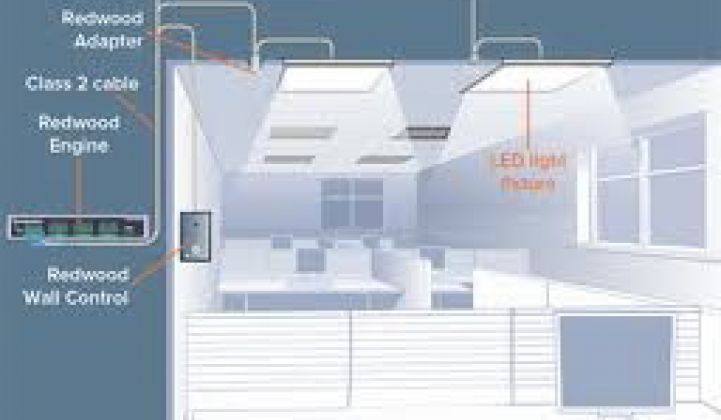There are a lot of smart lighting startups trying the wireless route to network lights for better efficiency. Then there’s Redwood Systems, the startup that wants to control your lights over Ethernet cable. On Wednesday, the Fremont, Calif.-based startup announced a $11.75 million Series C round, with investors including Battery Ventures, U.S. Venture Partners, Index Ventures and Mitsui & Co, Ltd.
Redwood has raised about $30 million since its 2008 founding for its unusual LED-over-Ethernet power and control technology, and now deploys its system with customers including Johnson Controls, SAP, Volkswagen and Facebook.
It’s also branched out into controlling fluorescent lights, high intensity discharge (HID) lights, and others via its controller-to-fixture low-voltage wiring network. Early this month, it made its first move outside the United States, announcing a partnership with French mega-utility EDF and cabling partners Anixter and CommScope.
Sam Klepper, Redwood's chief marketing officer and executive vice president of building solutions, said in a Wednesday interview that the Series C round is aimed at expanding growth into new markets. Asia is a particular focus, he said, given the company’s strategic partnership with Mitsui, which invested $3.5 million in the company in June 2011. The company raised $15 million in a Series B round in October 2011, and $4 million in a Series A round.
The new round is also aimed at bringing some new features to Redwood’s network in the ceiling, he said, with potential uses like occupancy sensing that feeds into conference room management systems. Klepper didn’t give any particulars on what Redwood was working on or with which partners, though he said an announcement is expected in June.
While the equipment costs of Redwood’s networked LED lighting architecture are about 10 percent to 20 percent more than traditional lighting setups, it can pay itself back in reduced installation costs alone, Klepper said -- low-voltage cables for power means no expensive electricians and faster deployment. That doesn’t include the plummeting costs of LEDs, which have fallen roughly in half over the past 18 months or so, he noted.
Once they’re in, Redwood’s installations have yielded 70 percent to 80 percent energy savings, compared to a typical, high-efficiency fluorescent lighting system, in customer environments like offices and data centers, he said. Those benefits can come both from the high efficiency and long-life features of LEDs to replace fluorescent tubes, or via controls alone, he said.
One data center client was able to shave 85 percent from its fluorescent lighting bills by dimming the lights just enough so that the security cameras could make out what they were looking at, and no more, for example. Office environments require more sensitive controls, like occupancy sensors, which come on board Redwood’s lighting control node that sits at, or as part of, every lighting fixture.
One big question for Redwood is how quickly LEDs will take hold as a viable alternative for mainstream building lighting. The startup’s February decision to support multiple lighting types would appear to lessen the company’s dependence on this growth to some extent.
Another big question is how well a cabled solution pencils out against the host of wireless lighting networks out there. Startups like Adura, Daintree Networks, Enlighted, Digital Lumens and others say their wireless networks cost far less than hard-wired alternatives. These companies have millions of square feet of projects underway to test their reliability and energy efficiency benefits.
Still, less than 10 percent of buildings now have smart lighting systems installed, making it a potentially wide-open market for startups, as well as lighting giants like Philips, which estimates the global lighting market at $75 billion and growing. Even a small increase in the share of that pie that goes to next-generation smart lighting systems could make a significant market for contenders in the field.



